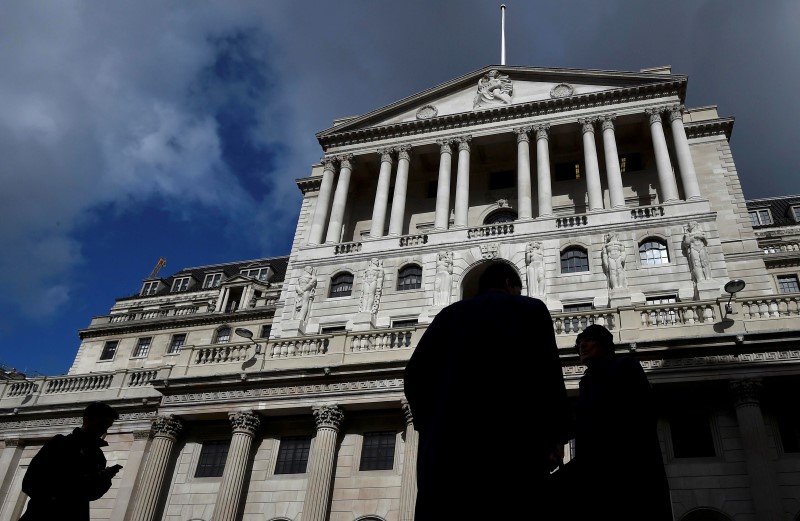By Ana Nicolaci da Costa
LONDON (Reuters) - As the Bank of England faces its biggest challenge since the global financial crisis, it may have to get creative about how to stimulate the economy after Britain's voted to leave the European Union, at a time when monetary policy is close to exhausted.
The central bank has said it may announce a package of measures to supplement an interest rate cut that is expected next month.
BoE Governor Mark Carney said a week after the June 23 referendum on the EU that the options for economic stimulus go beyond measures taken during the last crisis. Now economists are speculating about just how innovative the central bank will get.
It has already offered extra funds to banks in the weeks around the vote to keep financial markets running smoothly and lowered the amount of capital banks must hold in reserve to make sure they keep up lending.
Here are some of the options for the BoE:
INTEREST RATE CUTS
The Bank of England has flagged that it is likely to reduce interest rates on Aug. 4, at the end of its next meeting.
After it surprised financial markets by keeping rates at historic lows of 0.5 percent in July, a strong majority of the 36 economists polled by Reuters this week expected the Bank to cut interest rates by 25 basis points in August. Some expected them to be cut to zero; a few expected no change.
Given how low interest rates already are, economists doubt another reduction will help the economy much. But it could bolster confidence by showing the Bank is ready to support growth, which is expected to slow.
NEGATIVE INTEREST RATES
Rates are only 50 basis points away from zero, and Carney is sceptical about going into negative territory, as the Bank of Japan and the European Central Bank have done.
Carney said in June that "if interest rates are too low (or negative), the hit to bank profitability could perversely reduce credit availability or even increase its overall price."
BoE policymaker Martin Weale said on Monday that the Bank was "exploring" the question of how low interest rates can go. But it needed to be careful not to take them so low as to inadvertently tighten monetary policy, he said.
BOND-BUYING
A majority of economists in the Reuters poll said the Bank would revive its quantitative easing programme, most likely also in August.
Following the lead of central banks in Japan and the United States, the Bank created 375 billion pounds between 2009 and 2012 through purchases of government bonds, to get money flowing through the economy.
Quantitative easing can help growth by keeping bond yields - or borrowing costs - low and by boosting confidence that the central bank is willing to provide the economy with support.
But economists worry that the more it is used, the less effective it will be, especially with government bond yields at record lows. Critics say the plan mostly helps wealthy shareholders and property owners.
OTHER QUANTITATIVE EASING OPTIONS
The Bank of England could buy assets other than government debt, for example corporate bonds, if business investment falls sharply and corporate funding costs start rising. It purchased a small amount of corporate bonds when it first started QE.
But HSBC said in a recent note this would be "no panacea". Corporate bonds represent less than a third of borrowing by companies and less than half of that is in sterling.
If the Bank does not want to increase the range of asset purchases, it could shorten the maturity of its gilt portfolio, economists at Investec have said. That would involve selling long-dated bonds and buying short-term paper in a reversal of the U.S. Federal Reserve's "Operation Twist."
This could help homeowners by lowering fixed-term mortgage rates. Investec said over 80 percent of new mortgage business takes place at fixed rates and mainly at short maturities.
EXTENSION OF FUNDING FOR LENDING
The Bank of England could also opt to extend its Funding for Lending Scheme launched, along with the Treasury, in 2012 to help increase UK bank lending to the economy.
Under the scheme, which is due to end in January 2018, commercial banks can get cheap funding by borrowing Treasury bills in exchange for eligible collateral. Incentives to increase lending are skewed towards small and medium sized enterprises.
"It would be easy for the Bank of England to extend the scheme (beyond the January 2018 end-date) whilst it could be widened to include households to support the housing market," Investec said.
This could help if there was a credit crunch for households or for small firms by providing lenders with a backstop, but it would not restore demand for credit, HSBC said.
DIPPING INTO FISCAL TERRITORY
Economists expecting something new from the Bank say it could opt for some sort of coordinated action with the British Treasury to stimulate the economy.
One option is for the Bank to offer to buy a certain amount of gilts, to help the government fund a temporary tax cut or spend the equivalent amount.
The government might issue infrastructure bonds, which the Bank would purchase, to finance projects.
"The only slight disadvantage of that one is do we have enough shovel-ready projects for infrastructure? Some of these projects take a long time to do," Sushil Wadhwani, a former member of the BoE's monetary policy committee said.
But he said any coordination is likely to be more subtle.

"I think they will try and keep it as much 'business as usual' as possible," said Wadhwani, chief executive of Wadhwani Asset Management. "So we will get some fiscal stimulus later in the autumn and the Bank will front-run it by doing some QE and they will pretend that there is no connection."
(Additional Reporting by Andy Bruce and Jonathan Cable, editing by Larry King)